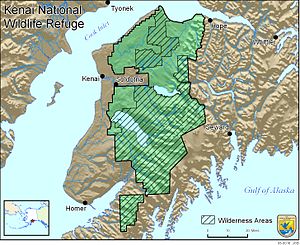 |
A study conducted by the U.S. Fish and Wildlife Service and the U.S. Forest Service has produced the first estimate of brown bear population size on the Kenai Peninsula using local field data. Conducted in June 2010 on the Kenai National Wildlife Refuge and the Chugach National Forest, the study concluded that the best estimate is 624 brown bears. Prior to the study, land and wildlife managers lacked information on the number of bears in the area.
Scientists arrived at the final estimate for the Peninsula through two steps. First, they used field methods and DNA analysis to sample the brown bear population on a well defined study area that included 70% of the Peninsula’s available brown bear habitat. This yielded an estimate of 428 brown bears (with a 95% confidence interval of 353 – 539 bears) on the 2.9 million-acre study area. The scientists then used the best estimate of brown bears on the study area and expanded it to available bear habitat on the entire Peninsula, producing the estimated total of 624 bears.
Federal and State resource managers on the Kenai Peninsula have long recognized the importance of developing a population estimate to guide brown bear management. Terri Marceron, Forest Supervisor on the Chugach National Forest noted that the investigation was both valuable and timely. “Brown bears serve important functions in ecosystems on the Peninsula, and are highly valued by residents and visitors.” She added, “As we initiate Forest Plan Revision in February, our first phase will be sharing status and trend information on various resources, including this new data on brown bears.”
The study used a methodology called mark-recapture, which relied on identifying individual bears through analysis of DNA extracted from hair samples collected on a grid across the study area. Hair samples were obtained by attracting bears to barbed-wire enclosures, each of which surrounded a scented lure. The accuracy of the population estimate was improved using information from radio-collared bears known to frequent the study area; which was made available through independent studies being conducted by the Alaska Department of Fish and Game.
The estimate includes both cubs and adult bears. Using information on the average litter size of cubs accompanying radio-collared female bears on the study area and the overall sex ratio determined from this study, the estimate of 624 bears translates into approximately 200 adult female, 200 adult male, and 224 cubs.
Results of the study are detailed in the report The Kenai Brown Bear Population on Kenai National Wildlife Refuge and Chugach National Forest. The study’s lead scientists, Dr. John Morton, supervisory wildlife biologist at the Kenai National Wildlife Refuge; Martin Bray, a Chugach National Forest wildlife biologist; and Dr. Greg Hayward, wildlife ecologist for the U.S. Forest Service’s Alaska Region, were assisted by two experts in their respective fields. Dr. David Paetkau, who conducted the DNA analysis, heads Wildlife Genetics International, a renowned wildlife genetics laboratory in Nelson, British Columbia. Dr. Gary White, professor emeritus at Colorado State University, conducted the data analyses which generated the population estimate. Dr. White is one of the world’s leading experts on wildlife population estimation using mark-recapture methodology.
Andy Loranger, Refuge Manager of the Kenai National Wildlife Refuge, described the importance of the study’s results. “Kenai brown bears are a highly valued wildlife resource. Enumerating bears in heavily forested habitats like those on the Kenai and over large areas encompassing millions of acres is extremely challenging. This estimate of the Kenai brown bear population is an important piece of scientific information that will help inform land and resource management decisions and benefit the long-term conservation of this iconic wildlife species.”

No comments:
Post a Comment